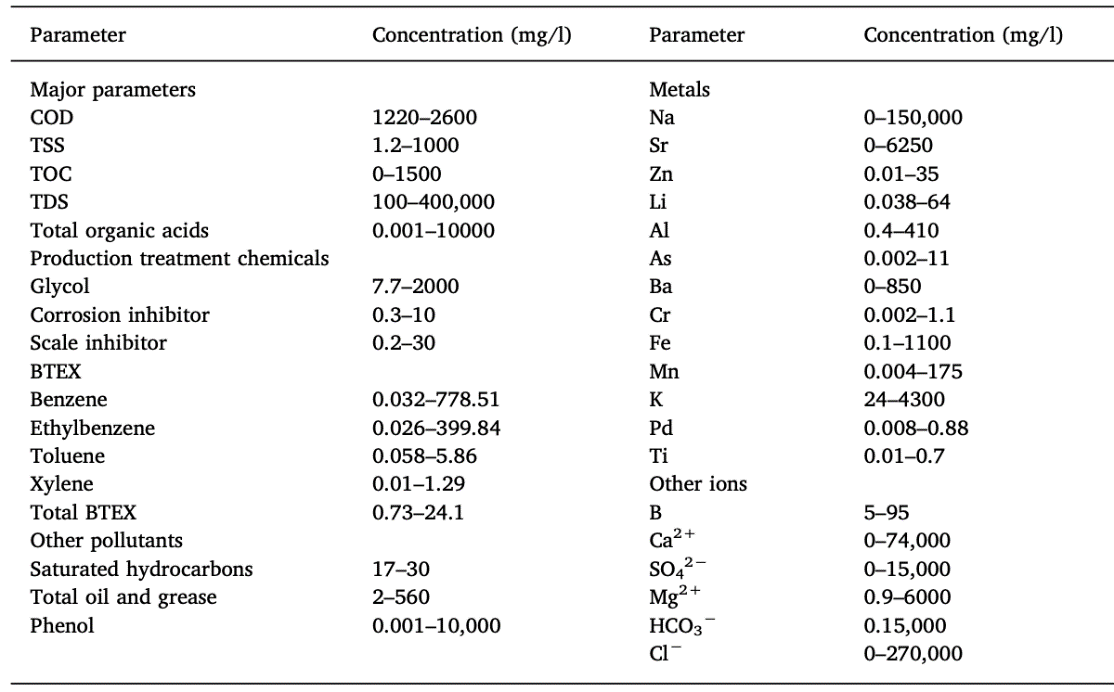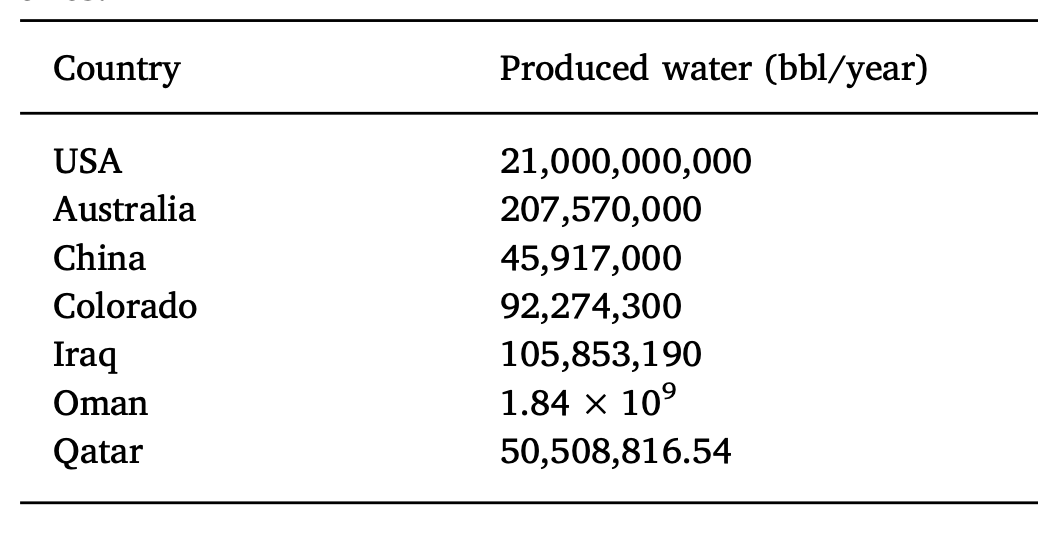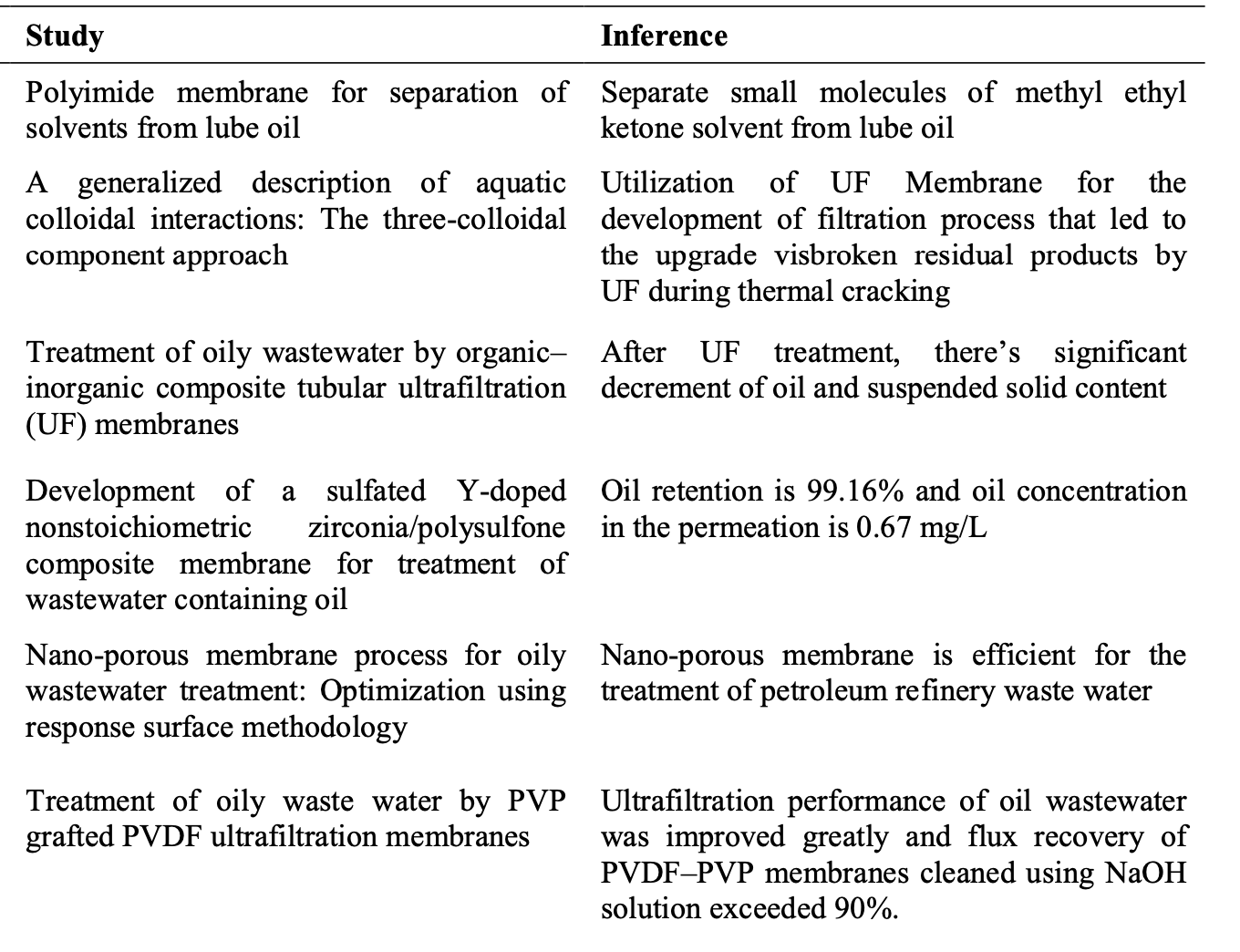Abstract
After crude oil rectification, the residue remains produced water, which is essentially an oil/water emulsion saturated with organic and inorganic inclusions. Such water poses an environmental hazard to nature and humans and therefore, reliable separation of water from the mixture requires. The purified resource has the potential to enter the natural cycle and become a source of clean drinking water for the population or agricultural purposes. The focus of this work has been on a study of the use of membrane technology for treating process water. It has been shown that at both research levels, laboratory and pilot, the total amount of oil removed is high enough to postulate that the membranes have a promising future. However, they are not without a number of drawbacks, such as natural material contamination, and therefore, future work must address these issues.
Introduction
In recent decades, the oil and gas industry has reached an enormous scale in the introduction and utilisation of natural resource-based energy generation technologies. The social and economic life of humanity in the 21st century is closely tied to the use of oil as a fuel, which justifies the annually increasing volumes of this resource produced. Crude oil, with its complex chemical composition, requires careful preparation and refining for further use (Wan Ikhsan et al., 2017). For instance, one of the most important wastes of the oil treatment procedure is produced water, which in recent years has been the subject of increased attention by researchers in the field of colloid chemistry, physical and chemical separation methods and the oil and gas industry.
Produced water is a natural satellite of oil and gas that lies in the earth’s strata all over the planet. In the fields, the water layers are adjacent to oil or gas deposits, and during the technical development process, the water streams connect to natural resources to form complex water/organic emulsions with the inclusion of various types of inorganic substances: metals, oxides, and sand (Al-Ghouti et al., 2019). It seems evident that the use of such a mixture has no commercial or technological justification since water significantly reduces the energy efficiency of oil. The traditional separation tools used for decades by oil and gas industry specialists are rectification and separation used to extract oil from an emulsion. Although these methods produce technically clean oil that is sent to distribution centres, such schemes nevertheless give residual water that is not suitable for drinking and hygienic purposes. Moreover, even in oil extracts, the water content is often 3:1 (Al-Ghouti et al., 2019; Dickhout et al., 2017). In other words, even without most oil, the produced water still contains organic and inorganic impurities (Figure 1), which must be disposed of in advance before waste can be disposed of.

Of primary importance in the context of this issue is the recognition that unscrupulous oil producers are ignoring existing regulations and legal norms that prohibit the mixing of residual, produced water with natural water ecosystems. Al-Ghouti et al. (2019) estimate that the annual number of barrels of such water is 70 billion, with one-third of this coming from the US alone, as shown in Figure 2. However, Rezakazemi, Khajeh and Mesbah (2018) showed other numbers: the authors consider that this number exceeds 88 billion barrels annually. This information reflects general trends in the global community towards increased demand for oil, which consequently raises the amount of produced water (Wan Ikhsan et al., 2017).

The problem of recycling such a resource is one of the central challenges facing the environmental monitoring departments of both oil and gas companies and entire countries. Contrary to existing prohibitions, oil producers continue to discharge residual water into the natural environment, although the general trend is negative (Al-Ghouti et al., 2019). There are at least two factors that illustrate the inadequacy of such policies. Firstly, it is known that residual oil sediments in water used by humans are carcinogenic, which affects the general national security of the state (Huang, Ras, and Tian, 2018). In other words, produced water that is pumped into waste streams leads to the development of cancer, which cannot be justified either by the commercial or technological characteristics of fuel production. At the same time, residual water has the potential to become a useful resource for the agricultural and food industry if a number of treatment measures have been taken in advance. It is well known that modern society is facing an increasingly acute shortage of clean water, and ignoring such enormous amounts of a potentially useful resource is considered unacceptable (Dickhout et al., 2017). For this reason, in conjunction with the development of policy models for regulating technological treatment, further research work is needed on improving and optimising methods for separating water/oil emulsion.
The Overview of Research in the Field of Cleaning Measures
Initially, it must be recognised that produced water is not a new phenomenon in the oil and gas industry, which means that the water has been treated since the design of the first fractionating column. It is likely that even at the initial stages of industrial oil use, specialists were concerned about the rational use of waste, so at this point, there are a large number of physical, chemical and biological methods of purifying water from foreign organic and inorganic pollutants. Over time, traditional options such as coagulation, mesh filtration, electrolysis, ultrasonic separation, degreasing, hydrocyclones and centrifuges have begun to be replaced by more advanced methods of separation of blending components (Al-Ghouti et al., 2019; Dickhout et al., 2017; Gupta et al., 2017; Jepsen et al., 2018). Recent discoveries in this area include the use of membrane technology based on the selective permeability of the mixture through the physical membrane. The central factor stimulating the transition from traditional forms of separation to the use of membranes is the increased efficiency of the process, coupled with the relative cheapness of the technology. However, there are other reasons why membranes are becoming increasingly popular and will be discussed in more detail in the next subsections.
The fundamental difference between the two levels of research, laboratory and pilot, is the approach taken to analysing developments. Obviously, in laboratory conditions, specialists are most often unable to use real commercial water, and therefore, they create analogues of oil/water emulsions (Gupta et al., 2017). On the contrary, the industrial scale of the experiments makes it possible to evaluate the hypotheses directly in treatment plants with real residual water. At the same time, laboratory researchers are more adaptive and diverse, as the central mission of such projects is to discover science rather than actually purify water. For this reason, authors often use highly specialised methods and modify the membranes, although such research is unlikely to be feasible under industrial conditions.
Lab Scale Research of Membranes For Oil/Water Separation
The laboratory level of research is incredibly useful in the context of testing scientific hypotheses and developing theoretical and practical knowledge about the nature of emulsion processes and the factors that influence external and internal forces on water separation. Emulsions themselves are thermodynamically unstable since the processes that occur in them spontaneously aim to reduce the partition surface, to merge dispersed particles with each other, which may eventually lead to a complete separation of the system into two phases (Dickhout et al., 2017). Laboratory technicians use this phenomenon to create membranes oriented towards this imbalance of the liquid system.
The principal focus of laboratory testing is to modify existing membranes so that they are as compatible as possible with the contaminants to be removed. First of all, it is essential to note that two types of membranes, namely ceramic and polymer, have gained wide popularity in the scientific community. The ceramic composition is an inorganic substance with increased resistance to the flow of produced water (Dickhout et al., 2017; Wan Ikhsan et al., 2017). Such systems do not swell in water and are relatively easy to treat. However, according to Dickhout et al. (2017), the main disadvantages of ceramic membranes are their cost and high weight. For this reason, most laboratory-level studies are aimed at using the second type of membrane, the polymer one. These are incredibly diverse systems that not only can be based on different polymers, such as PVC, HDPE, PS, PP but also may include various organic and inorganic components.
Polymeric membranes modified with alumina nanoparticles demonstrate increased hydrophilicity, which is equivalent to an improved water treatment regime (Huang, Ras, and Tian, 2018). The membrane wetted with water molecules turns out to be oleophobic, which means that hydrocarbon molecules cannot penetrate the barrier: the profitability of the process was 98% (Dickhout et al., 2017). Similar results are also typical of polysulfone membranes, modified PEG molecules, which showed high water purification results and met the established quality control and inspection standards. The second side of this effect of the zwitterionic hydrophilic layer is the optimization of the purification processes, where electrically neutral charges of the modifier create an outer monomolecular shell of the membrane that protects it from the deposition of pollutants (Rezakazemi, Khajeh and Mesbah, 2018). Research in this area has been further developed to assess the effectiveness of ceramic membranes and polyamide matrix-based materials. Dickhout et al. (2017) showed that an ultrafiltration membrane from silicon dioxide removes up to 95% of oil, while for polyamide materials, it is only 83%. As can be seen in Figure 3, the general trend in laboratory studies is to verify the performance of specific compositions with a view to their possible future use on an industrial scale.

In the meantime, special attention should be paid to the shortcomings of the laboratory level, which may lead to a violation of the scalability of results. Dickhout et al. (2017) showed that most laboratory membranes were dealing with synthetic water/oil emulsion that does not always match the actual conditions. In general, it is worth noting that produced water is not a standard mixture of oil and water, but contains a large number of additional components, and the final chemical composition depends on the field and the age of the source (Gupta et al., 2017). This means that semipermeable or osmotic membranes that have shown results under laboratory conditions may not have the same performance on a large scale as the dynamic transitions of produced water flows (Jepsen et al., 2018). In other words, there is a need for additional experimental evaluation of the consistency of the results between the two study levels.
Pilot Scale Research of Membranes for Oil/Water Separation
Experimental pilot studies allow the scientific and engineering community to assess current information on the limits of applicability of specific models on an industrial scale. Dickhout et al. (2017) reported three commercially successful implementations of membrane technology in wastewater treatment plants: polymeric ultrafiltration membranes, reverse osmosis membranes and hydrophilic spiral systems. Pilot testing of the first type of membrane was carried out in the Snorre oil field in the Norwegian North Sea: about 96% of the oil was removed from the real water/oil emulsion. In Thailand, reverse osmosis nanofiltration membranes were tested to remove smaller particles, and although no specific numbers were given by the authors, they pointed out that the smaller membrane pore size contributed to the reduction in pollution (Dickhout et al., 2017). The third type of membrane was tested in Texas, where a mixture pre-treated on hydrocyclones was amenable to spiral membrane filtration. The total level of oil that was removed from the emulsion reached 54%. Based on the data provided, it can be concluded that, overall, laboratory models have shown promising initial results of applicability on a large scale. Nevertheless, membrane technology still faces a number of challenges that need to be addressed in the future.
Conclusion
The oil and gas industry has faced the problem of utilising produced water in recent decades. In the context of environmental well-being and public health safety, the discharge of water and oil emulsions left during oil rectification into natural aquatic ecosystems is prohibited. While some companies are ignoring these regulations and continue to dispose of production waste, others are directing existing research and development efforts to find the best ways to clean up. For instance, oil/water emulsions have the potential to become clean drinking water after a multistage treatment procedure, which is relevant in countries where this resource is limited. Therefore, the treatment of water from impurities is a key task for the relevant departments of the companies.
Traditional separation methods do indeed show results, but they are being replaced by more advanced options: membrane technology. Membranes are, in fact, physical barriers that prevent the passage of some components of the mixture and allow water molecules to enter the tanks freely. Such technologies have become possible in many ways thanks to the discovery of the hydrophilicity of some modifiers that are added to the membrane matrix. For instance, the inclusion of aluminium oxide nanoparticles in the membrane makes it possible to improve field water treatment rates significantly. Most tests are conducted under laboratory conditions, where specialists are free to modify the membranes and check their effectiveness. However, laboratory materials often deal with synthetic water that does not have the same characteristics as a real emulsion. An additional stage of pilot testing to assess the performance of such membranes is then required for implementation in production. It has been shown that most pilot tests confirm the high efficiency of membranes for separating water from the emulsion.
No matter how excellent the membrane technology is, its operation presents a number of significant challenges that still need to be addressed in the coming decades. First and foremost, a cornerstone problem with membranes is their high rate of contamination, as the pores of the material are clogged with components of the mixture. There are several strategies for how this process can be inhibited, and active development towards hydrophilic resistant systems is underway. On the other hand, polymer composites are highly selectable to the mixture, consequently selecting the material for the membrane is a non-trivial task. Given the specific nature of the field, specialists must select a suitable membrane that does not dissolve or interact chemically with the flow of produced water. In addition, the main parameters of the effectiveness of the treatment process are the percentage of oil removed: the higher this number, the better the membrane has managed to filter. Future developments may focus on preliminary treatment procedures, such as centrifugation or the use of hydrocyclones, in order to increase the value of this parameter.
Reference List
Al-Ghouti, M.A., Al-Kaabi, M.A., Ashfaq, M.Y. and Da’na, D.A. (2019) ‘Produced water characteristics, treatment and reuse: a review’, Journal of Water Process Engineering, 28, pp. 222-239.
Dickhout, J.M., Moreno, J., Biesheuvel, P.M., Boels, L., Lammertink, R.G. and de Vos, W.M. (2017) ‘Produced water treatment by membranes: a review from a colloidal perspective’, Journal of Colloid and Interface Science, 487, pp. 523-534.
Gupta, R.K., Dunderdale, G.J., England, M.W. and Hozumi, A. (2017) ‘Oil/water separation techniques: a review of recent progresses and future directions’, Journal of Materials Chemistry A, 5(31), pp. 16025-16058.
Huang, S., Ras, R.H. and Tian, X. (2018) ‘Antifouling membranes for oily wastewater treatment: interplay between wetting and membrane fouling’, Current Opinion in Colloid & Interface Science, 36, pp. 90-109.
Jepsen, K.L., Bram, M.V., Pedersen, S. and Yang, Z. (2018) ‘Membrane fouling for produced water treatment: a review study from a process control perspective’, Water, 10(7), pp. 847-875.
Rezakazemi, M., Khajeh, A. and Mesbah, M. (2018) ‘Membrane filtration of wastewater from gas and oil production’, Environmental Chemistry Letters, 16(2), pp. 367-388.
Wan Ikhsan, S.N., Yusof, N., Aziz, F., and Misdan, N. (2017) ‘A review of oilfield wastewater treatment using membrane filtration over conventional technology’, Malaysian Journal of Analytical Sciences, 21(3), pp. 643-658.